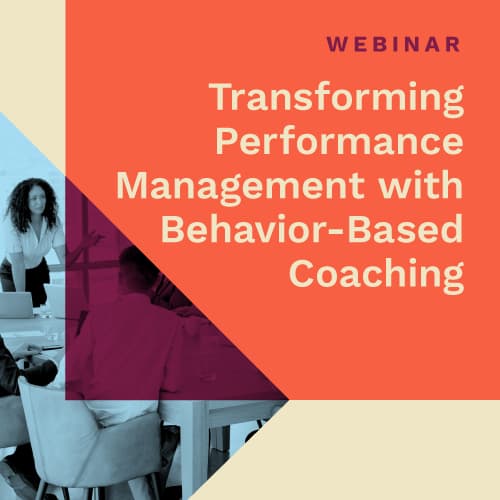Whether you are dealing with departmental growth or succession planning, it's always developing the next wave of leaders in your organization is always important. While there are several strategies to train employees with the knowledge and experience needed to successfully spearhead a team, one of the most effective and rewarding ways is through a leadership development mentoring program.
Specifically, use mentoring initiatives to train high-potentials in your organization to grow into organizational leaders by pairing them with experienced employees.
Besides harnessing the people you already have in your organization, an impactful mentoring program helps:
- Increase employee engagement and employee satisfaction
- Boost employee retention and recruiting efforts
- Provide the attention and training high-potentials need to excel
- Develop meaningful relationships between experienced leaders and those looking to develop new skills
- Allow seasoned employees to give back through a successful mentorship program
5 Steps To Designing a Successful Mentoring Program
Here are five steps to keep in mind when designing a leadership development program and mentoring process to equip your employees with the skills needed to make an impact on your organization.
Determine Program Objectives
Like many projects, establishing an effective program starts by outlining organizational goals. You'll need to answer essential questions like:
- Why you're creating the program
- What an ideal mentor looks like
- What success looks like for the participants
Since you're launching the program for leadership development, success might look like growing a team of effective leaders that can turn around and raise other leaders within your company. It could also look like nurturing a corporate culture that celebrates learning and change or training leadership on how to effectively lead teams. Leadership development programs should be filled with peer mentoring, the type of mentoring where employees can help each other grow and develop.
Whatever your objectives are, ensure that they meet the SMART benchmarks used to develop goals. SMART stands for:
- Specific
- Measurable
- Attainable
- Relevant
- Timely
You can also learn more about developing SMART goals by reading this article. Having goals that meet these criteria gives participants direction and provides leadership with insight into the importance of offering their support. These objectives guide you as you plan, launch, and continuously improve your mentorship program.
Establish a Structure
You know what goals you want to achieve—now it's time to figure out how to get there. When creating the formal mentoring process and program roadmap, think about the following:
- Mentees: What eligibility requirements will you outline for mentees? Will there be an application or referral process that applicants must complete?
- Mentors: How will your organization select potential mentors? How will mentors be held accountable to the program? What will mentorship training look like?
- Mentoring Relationship: Will it be one-on-one, or will mentors have multiple mentees? Will it include any peer mentoring?
- Mentoring Approach: Is there a set way for mentees and mentors to connect? Besides one-on-one meetings, are there e-mentoring options or group gatherings with other mentees/mentors in the program? How long will mentoring sessions be?
- Program Duration and Content: How long will the program last? The length of a mentorship program typically correlates to how long it takes to achieve the program goals. This can be anywhere from several months to a couple of years. Depending on the program length, how often will it take place—once or twice a year?
- Content: Can specific materials, such as leadership courses or workshops, be completed during the program? I have found some useful books and online courses that reinforce the topic of leadership, such as The Five Dysfunctions Of A Team: A Leadership Fable by Patrick Lencioni and various courses on MIT Open Courseware. However, no course materials can replace real-life experience or wisdom from those who have led people through projects or challenges.
- Workshops and Projects: What opportunities will mentees have to implement the skills they've been learning? Will your program host workshops that offer opportunities to exercise their leadership muscles, or will the company encourage mentees to co-lead certain projects within their department? This is when you pair conceptual learning with discussion and application.
- Rewards and Recognition: Will mentees receive recognition for completing the program? Will mentors receive some award or compensation for lending their time and expertise?
Once you've answered those questions, devise a workflow diagram or packet to summarize each step of the program process for participants. Include key deadlines, actions, criteria, and resources that are relevant to each step of the process. If participants must complete specific tasks or courses before moving on to the next phase of the program, make sure to clearly denote that information.
Remember that while having an established plan in place is helpful, it's also important to allow for flexibility. Mentors and mentees should have the opportunity to meet their preferred individual learning stylesand satisfy their mentoring needs and learning goals.
Announce the Program
When you have all the details, it's time to roll out the program and help it gain traction within your organization. However you choose to spread the word—through print (posters, signs, banners) or digital media (emails, websites, social media)—you need to communicate the following:
- Benefits: How will mentees grow from the program? How will mentors benefit from volunteering their time in this way? How will it help their career development?
- Eligibility: Who can participate in the program? Are there specific requirements (age, experience) that mentees and mentors need to have?
- Participation Requirements: What is expected to take part in the program? Are there certain events that mentees must attend or courses they must complete in the program?
- Program Success: While it may be difficult to have social proof when first launching the program, constantly update your communications with the program's progress and success. Once the program is up and running, are there any noticeable participants impacted by the program? Are there any success stories to share?
- Contact information: If someone has questions about the program, who should they connect with?
It may be helpful to create a pamphlet or a one-pager to help you communicate this information to potential participants. Don't just target specific applicants for the program. Instead, spread the news to all levels of the organization. Reach out to young employees that may consider the program a few years down the road, as well as upper-level leadership that can serve as mentors or support the program in other ways. Spread awareness and gain the support needed for the program to take off.
Connect and Train Participants
Now that you have a pool of mentees and mentors to work with, pair participants based on similarities in backgrounds, needs, learning styles, competencies, personality, and desired areas of growth. When you don't know applicants on a personal level, it can be challenging to set up pairs that will naturally click and work well together. Consider having applicants take a robust personality assessment to shine more light on the different characteristics you have to work with and what personality pairings might connect better than others.
Mentees should also be able to work towards their specific career goals in conjunction with the company's goals. A mentor that specializes in a role that aligns with a mentee's career goals will help optimize the relationship and opportunity for growth. For example, if someone is looking to grow as a leader in developing company culture, pair them with an HR Manager.
After you make introductions, set the relationship up for success by going over the mentor program basics.
Lay the foundation by addressing:
- Preparation: Talk about expectations, confidentiality, and relationship boundaries.
- Goals: Have mentees list their goals, making sure to connect them to the larger company objective.
- Agreements: Establish how mentors will assist mentees in achieving goals.
- Enabling: Discuss how mentors will provide help, support, constructive criticism, and accountability as the mentee moves towards their goal.
- Scheduling: Lock down a meeting schedule for mentorship sessions. Have a minimum frequency for them to meet—otherwise, other priorities may get in the way.
- Closure: Have pairs meet to close out the relationship, discuss what they've learned, talk about how they can use that information for ongoing improvement, and celebrate their success.
In this initial training, remember to provide resources and guidance as the program progresses to ensure participants successfully progress toward company and personal goals.
Software and Technology
Mentoring software can assist your mentoring program manager by automating some of the program's processes. Some key elements of mentoring platforms include:
- Match mentors and junior employees successfully
- Increase collaboration between mentors and mentees
- Manage your mentoring program
- Develop action plans to reach goals
Assess and Evaluate
It's important to track success, both throughout the duration of the formal mentoring program and after completing each program season. This allows you to make iterative changes to keep improving the process and create an effective mentoring program.
Gathering feedback in various ways, including retrospective group meetings and individual constructive feedback forms, can help you consistently improve your mentorship program.
Ask questions like:
- How challenging and useful was the course material?
- Would mentees refer their peers to complete the course?
- Were the relationship and program relevant to the mentee and their career path?
- How enjoyable was the program?
- Did mentors feel like their advice and time were respected?
- What challenges or difficulties were there during the program?
- What are two facets of the program that were done well and two facets that could be improved?
- How would you describe your mentoring experience?
- What advice would you give to future mentors?
To capitalize on your leadership development program and create a mentoring culture, it's important to treat it as much more than a one-time initiative. The program must be woven into your company culture to have the greatest impact.
To achieve this, appoint a program director or mentoring program manager, gain company-wide support from senior executives and other leaders throughout the organization, and make a point to continuously improve the program.
Reaching Further
For every leader—or anyone aspiring to be a leader—The Birkman Method eases the challenges of leadership by making communication easy. By diving into what motivates people and what they need from their environment to be successful, Birkman provides the information you need to understand your team, as well as the tools to build successful teams.

